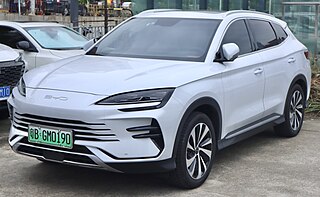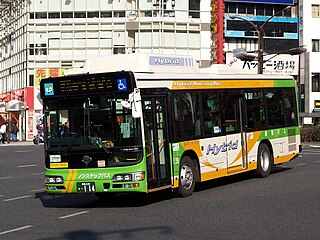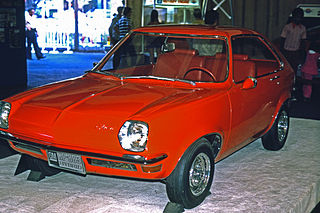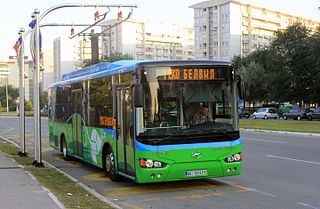
A hybrid vehicle is one that uses two or more distinct types of power, such as submarines that use diesel when surfaced and batteries when submerged. Other means to store energy include pressurized fluid in hydraulic hybrids.

A plug-in hybrid electric vehicle (PHEV) or simply plug-in hybrid is a type of hybrid electric vehicle equipped with a rechargeable battery pack that can be directly replenished via a charging cable plugged into an external electric power source, in addition to charging internally by its on-board internal combustion engine-powered generator. While PHEVs are predominantly passenger cars, there are also plug-in hybrid variants of sports cars, commercial vehicles, vans, utility trucks, buses, trains, motorcycles, mopeds, military vehicles and boats.

The FreedomCAR and Vehicle Technologies (FCVT) was a national Office of Energy Efficiency and Renewable Energy program developing more energy-efficient and environmentally-friendly highway transportation technologies to enable the United States to use less petroleum. Run by Michael Berube, it had long-term aims to develop "leap-frog" technologies to provide Americans with greater freedom of mobility and energy security, lower costs, and reduce environmental impacts.

A hybrid electric bus is a bus that combines a conventional internal combustion engine propulsion system with an electric propulsion system. These type of buses normally use a Diesel–electric powertrain and are also known as hybrid Diesel–electric buses.

The Opel Antara is a compact crossover SUV which was marketed by Opel from 2006 to 2015. Based on the Theta platform, the Antara closely shared its underpinnings and powertrains with the Chevrolet Captiva. However, it only offered five seats instead of seven, and features a different exterior and interior design. Sales commenced in November 2006, as the indirect successor to the Isuzu-based Frontera range.
Energy Conversion Devices (ECD) was an American photovoltaics manufacturer of thin-film solar cells made of amorphous silicon used in flexible laminates and in building-integrated photovoltaics. The company was also a manufacturer of rechargeable batteries and other renewable energy related products. ECD was headquartered in Rochester Hills, Michigan.
Mild hybrids (MHEV) are generally cars with an internal combustion engine (ICE) equipped with a minimally extended battery and an auxiliary electric combined motor and generator in a parallel hybrid configuration which is not enough for an electric-only mode of propulsion but does allow the engine to be stopped whenever the car is coasting, braking, or stopped, and then restarted once power is required again. Mild hybrids may employ regenerative braking and some level of power assist to the internal combustion engine.
Hybrid vehicle drivetrains transmit power to the driving wheels for hybrid vehicles. A hybrid vehicle has multiple forms of motive power.

An alternative fuel vehicle is a motor vehicle that runs on alternative fuel rather than traditional petroleum fuels. The term also refers to any technology powering an engine that does not solely involve petroleum. Because of a combination of factors, such as environmental and health concerns including climate change and air pollution, high oil-prices and the potential for peak oil, development of cleaner alternative fuels and advanced power systems for vehicles has become a high priority for many governments and vehicle manufacturers around the world.

In the late 1960s, General Motors Company directed its GM R&D and Pontiac divisions to develop concept mini-cars for urban drivers. GM developed the XP-883 an experimental plug-in hybrid car demonstrated by General Motors in 1969. Primarily intended as a commuter vehicle, the very small car had a fiberglass body with a design resembling the future Chevrolet Chevette. The two-door hatchback had seating for two adults and two children, though the children sat in rear-facing seats and would enter and exit through the tailgate. It was powered by the combination of a two-cylinder engine and a DC electric motor plus batteries. Electricity was stored in six 12-volt batteries placed between the rear wheels. The related Pontiac concept was the Pontiac X-4 with a radical two stroke aircraft type radial engine.

Andrew Alfonso Frank is an emeritus American professor of Mechanical and Aeronautical Engineering at University of California, Davis. He is recognized as the father of modern plug-in hybrids, and coined the term Plug-in Hybrid Electric Vehicle (PHEV).

CalCars was a charitable, non-profit organization founded in 2002 to promote plug-in hybrid electric vehicles (PHEVs) as a key to addressing oil dependence and global warming both nationally and internationally. It was active until 2010, when the first mass-produced PHEVs arrived. CalCars envisioned millions of plug-in hybrid electric vehicles, charged by off-peak electricity from renewable energy sources, and with their internal combustion engines powered by low-carbon alternative fuels, as a way to significantly reduce greenhouse gases that come from transportation.
All-electric range (AER) is the maximum driving range of an electric vehicle using only power from its on-board battery pack to traverse a given driving cycle. In the case of a Battery electric vehicle (BEV), it means the maximum range per recharge, typically between 150 and 400 miles. For a plug-in hybrid electric vehicle (PHEV), it means the maximum range in charge-depleting mode, typically between 20 and 40 miles. PHEVs can travel considerably further in charge-sustaining mode which utilizes both fuel combustion and the on-board battery pack like a conventional hybrid electric vehicle (HEV).

The history of plug-in hybrid electric vehicles (PHEVs) spans a little more than a century, but most of the significant commercial developments have taken place after 2002. The revival of interest in this automotive technology together with all-electric cars is due to advances in battery and power management technologies, and concerns about increasingly volatile oil prices and supply disruption, and also the need to reduce greenhouse gas emissions. Between 2003 and 2010 most PHEVs on the roads were conversions of production hybrid electric vehicles, and the most prominent PHEVs were aftermarket conversions of 2004 or later Toyota Prius, which have had plug-in charging and more lead–acid batteries added and their electric-only range extended.

Valence Technology, Inc. was a company that developed and manufactured lithium iron phosphate cathode material as well as lithium ion battery modules and packs. The modules come in 12 V, 18 V, 24 V, and 36 V configurations. Valence's products are used in electric vehicle and plug-in hybrid electric vehicles (PHEVs) such as cars, scooters, motorbikes, and commercial vehicles such as buses, delivery vans and trucks. Valence batteries are also used in wheelchairs, medical carts, robotics, marine, rail, as well as stationary applications such as remote power, uninterruptible power supply (UPS), energy storage systems, frequency regulation and switching gear.

An electric vehicle battery is a rechargeable battery used to power the electric motors of a battery electric vehicle (BEV) or hybrid electric vehicle (HEV).

A plug-in electric vehicle (PEV) is any road vehicle that can utilize an external source of electricity to store electrical energy within its onboard rechargeable battery packs, to power an electric motor and help propelling the wheels. PEV is a subset of electric vehicles, and includes all-electric/battery electric vehicles (BEVs) and plug-in hybrid electric vehicles (PHEVs). Sales of the first series production plug-in electric vehicles began in December 2008 with the introduction of the plug-in hybrid BYD F3DM, and then with the all-electric Mitsubishi i-MiEV in July 2009, but global retail sales only gained traction after the introduction of the mass production all-electric Nissan Leaf and the plug-in hybrid Chevrolet Volt in December 2010.

A capacitor electric vehicle is a vehicle that uses supercapacitors to store electricity.

Edward W. Furia was Project Director of the Earth Week Committee of Philadelphia during the first Earth Day in 1970.

A range extender is a fuel-based auxiliary power unit (APU) that extends the range of a battery electric vehicle by driving an electric generator that charges the vehicle's battery. This arrangement is known as a series hybrid drivetrain. The most commonly used range extenders are internal combustion engines, but fuel-cells or other engine types can be used.


















